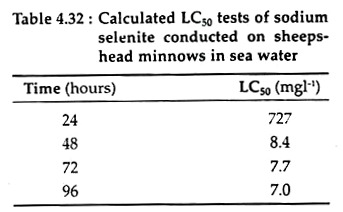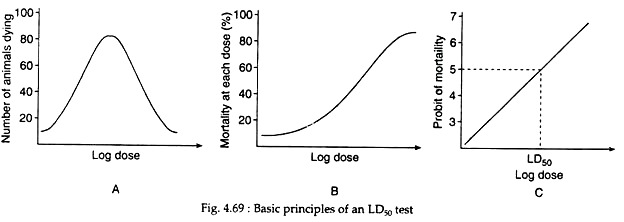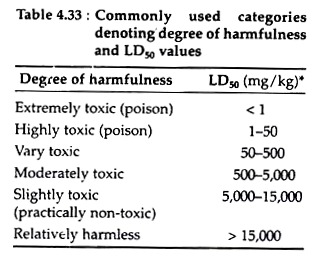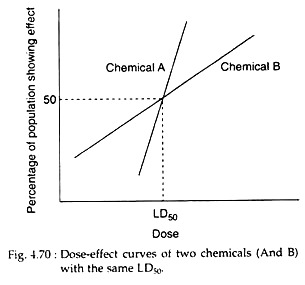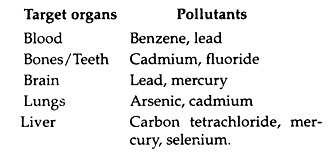In this article we will discuss about the acute and chronic toxic effects of chemical exposure on organisms.
Acute Toxic Effects:
Acute toxic effects are those that occur shortly after exposure to a relatively high dose of a toxicant. These effects occur rapidly as a result of short term exposure of a few hours, days or weeks to a chemical.
Asphyxiants, explosives, pyrophorics, organic peroxides, water reactive and unstable/reactive chemicals, corrosives and poisons, typically produce acute effects. Generally, acute effects are severe causing lethality or mortality.
Acute Toxicity Tests:
ADVERTISEMENTS:
Acute toxicity tests are designed to determine the dose or concentration of a particular test chemical or effluent that will produce a specific response/ effect on a group of test organisms, under controlled conditions. The common tests are lethality, irritation studies and potentiation or sensitizing agents.
(a) Lethality (LC50, LD50) tests:
This is one of the most widely used tests to express acute toxicity. LC50 is used to denote the lethal concentration necessary to kill 50% of a large population of test species under stated conditions. This is done experimentally by administering a chemical at a particular graded dose, to a group of organisms and then observing the resultant effect (mortality) at a set time period, say 96 hours or so. The test species are rats, mice, rabbits, guinea pigs, hamsters etc.
To calculate LC50 a number of methods can be used of which three independent approaches are:
ADVERTISEMENTS:
(i) Parametric method,
(ii) Moving average method, and
(iii) Non-parametric method.
The most frequently used LC50 value calculation are parametric methods. If an asymptote has been reached in the toxicity curve (such as acute lethality has ceased), then the final value should be called incipient LC50 on threshold lethal concentration.
ADVERTISEMENTS:
Test methods for acute toxicity are done in accordance to length of exposure, test situation, criteria of effects and test organisms. In earlier acute toxicity tests, data were expressed as the median tolerance limit (TLm or TL50).
It is expressed as the test material concentration at which 50% of the test organisms survive for a specific exposure time (usually 24-96 hours). This term has now been replaced by median lethal concentration (LC50) and median effective concentration (EC50).
There are several methods by which test organisms may be exposed to test materials. These methods, for example, in aquatic systems, are static, recirculation, renewal or flow-through methods. Thus, a common acute testing approach is to design a test so that a quantal response (an all-or-none response that is dead or alive) is elicited. Then a concentration mortality curve can be plotted depending on the relation between test material concentration and the percentage of exposed organisms affected.
Such short term tests can be expressed as:
(i) The percentage of organisms killed or immobilised in each concentration, and
(ii) The LC50 or EC50 derived by observation, interpolation or calculation.
Test data on acute toxicity tests conducted on sheepshead minnows are given in the Table 4.32:
LD50 (Lethal median dose) toxicity test is the measure of the dose at which 50% of the test organisms (of the same species) are killed within a specified period. It essentially means that any one organism exposed to that close has a 50/50 chance of dying. If other than lethality, the effect of exposure to some toxic is of interest (example: loss of hair etc.), then ED50 (effective dose) can be determined.
ADVERTISEMENTS:
LD50 (also ED50) data are based on experiments or epidemiological studies, where the chemical is introduced into the organism through inhalation, injection etc. Fig. 4.69 illustrates the basic principles of an LD50 test. A number of animals are exposed to the pollutant over a range of concentrations.
For convenience it is usually expressed as log dose. If this range is properly selected, a more or less normal distribution of responses will occur (Fig. 4.69A). This means that a small number of individuals will die at very low concentrations and only a few will survive at very high concentrations, while majority will die at over a range of intermediate doses.
If this data is redrawn by plotting the proportion of individuals at each dose (that is, the percentage response at each dose), then a sigmoidal dose-response curve will result (Fig. 4.69B). The final step is to straighten this line. Several methods are available enabling its slope (the rate of response to increasing dose) to be easily calculated.
This can be done by expressing the deviation from the mean as a probability unit or profit (Fig. 4.69C). The dose at which 50% of the population is killed can easily be read off the line. An environmental standard is based on the LD50 by applying a safety margin by simply multiplying the value with some factor, say 0.1.
The concentration of the toxic chemical in the atmosphere or water, where the test organism lives is known in many cases but the amount actually taken into the organism is unknown. In such instances, LC50 and EC50 are used. Values of LD50 and LC50 are useful for defining relative toxicities. Evaluation of LD50 in several animal species is a fair guide to the acute lethal toxicity of the same compound in man.
LD50 values and commonly used categories of relative toxicity are given in Table 4.33. LD50 is a calculated value and is accompanied by a statement of the error of the estimated value. The smaller the LD50 values, the more toxic a chemical is and thus, the toxicants can be graded according to their LD50 values (as given in Table 4.33).
LD50 values are also useful in making an objective comparison of inherent toxicity of different compounds. The dose-effect curves for two different chemicals are shown in Fig. 4.70. Here, although both the chemicals A and B have equal LD50s, incremental increase in dose results in greater increases in percentage of population affected for chemical A than for chemical B.
The LD50 method was originally devised to measure the toxicity of a range of drugs for human consumption at a time when no effective method was available. Although LD50 is widely used to assess the environmental toxicity of many pollutants it has a number of limitations, which are listed:
1. It is based upon a limited period of exposure.
2. It is based upon a single species.
3. A single test can only measure the impact on one sex or one stage of the life cycle.
4. It makes no allowance for the effect of a toxic burden on interactions with other species.
5. It makes no allowance for synergistic interactions with other pollutants.
6. The test is unable to measure the impact on the reproductive potential of a species.
7. The LD50 toxicity test is insensitive to chronic toxic effects that may in the long term effect survival.
8. To assess the ecological impact of a pollutant, the effectiveness of the test relies upon the correct choice of a sensitive species.
9. The test organism has to be standardised for size, sex and health. It also has to be acclimatized to the test conditions before exposure to the pollutant.
In practice the LD50 test conditions are a compromise between what is desirable and what is actually feasible. As for example, LD50 tests are generally conducted on easily handled adult animals. However, the younger forms of these animals are more sensitive. Another example, is the larval crabs, the growth rate of these are most sensitive indicators of zinc and copper toxicity, but the rates are not easily or rapidly measured.
(b) Skin and eye tests:
Skin and eye tests are conducted with chemicals that act as primary irritants. These when applied to the skin or mucous membranes lead to various types of tissue alternatives. These tests are conducted generally on rabbits, mice, guinea pigs etc. and the tissue damage is recorded subjectively.
For example, when these chemicals are applied to the eye of the test animals, the tissue response may lead to toxic manifestations such as corneal damage and blindness. When inhaled it may destroy tissues in the respiratory tract. Awareness of such effects on primary tissues, for a specific chemical could alert individuals to handle the chemical with proper care.
(c) Potentiation:
Potentiation or sensitization means that when two chemicals are acting on the same or different organs or systems, one chemical acts more effectively in the presence of the other. This potential sensitisation effect of chemical agents is a major problem to toxicologists. To distinguish between a substance acting as a primary irritant and one acting as a sensitizing agent, is another problem.
The primary irritant elicits its effects immediately on application, while the sensitizing agent may show no primary irritation. Sensitizing agent when applied or injected may combine with a protein molecule and act as an antigenic agent, which, in turn, produces antibodies. The tests are generally conducted on guinea pigs. In man, patch testing is often used, but only after preliminary animal sensitizing tests have been conducted.
Sub-acute Toxicity:
Sub-acute exposures comprise of instances where a population is exposed repeatedly to a toxicant over a period of several days or months. It generally involves more than 21 days exposure. Such studies are carried out at three or more dose levels, in two or more species. One of the major objectives of such tests is to establish a dose which could be classified as no effect dose. Anything above this dose would be considered as harmful to man.
Sub-acute toxicity tests also provide information on the major toxic effects of a chemical pollutant and the target organ affected (as given below):
Chronic Toxic Effects:
Chronic toxicity effects are those that occur over long periods of time exposures (for decades on years), including effect of sensitizers and carcinogens. For example, many lung cancers related to exposure to asbestos and cigarette smokes develop only after a long period of 40 years. As chronic effects become apparent only after a long period of exposure, they are particularly difficult to relate to a specific exposure of a particular toxicant.
Thus, our current state of knowledge regarding the potential effects of the more than 60,000 chemicals in daily commerce is more extensive in case of their acute effects than in their chronic effects. This is mainly due to the methodological difficulties involved in the scientific investigation of chronic effects, which, however, does not imply that chronic effects are of less concern.
